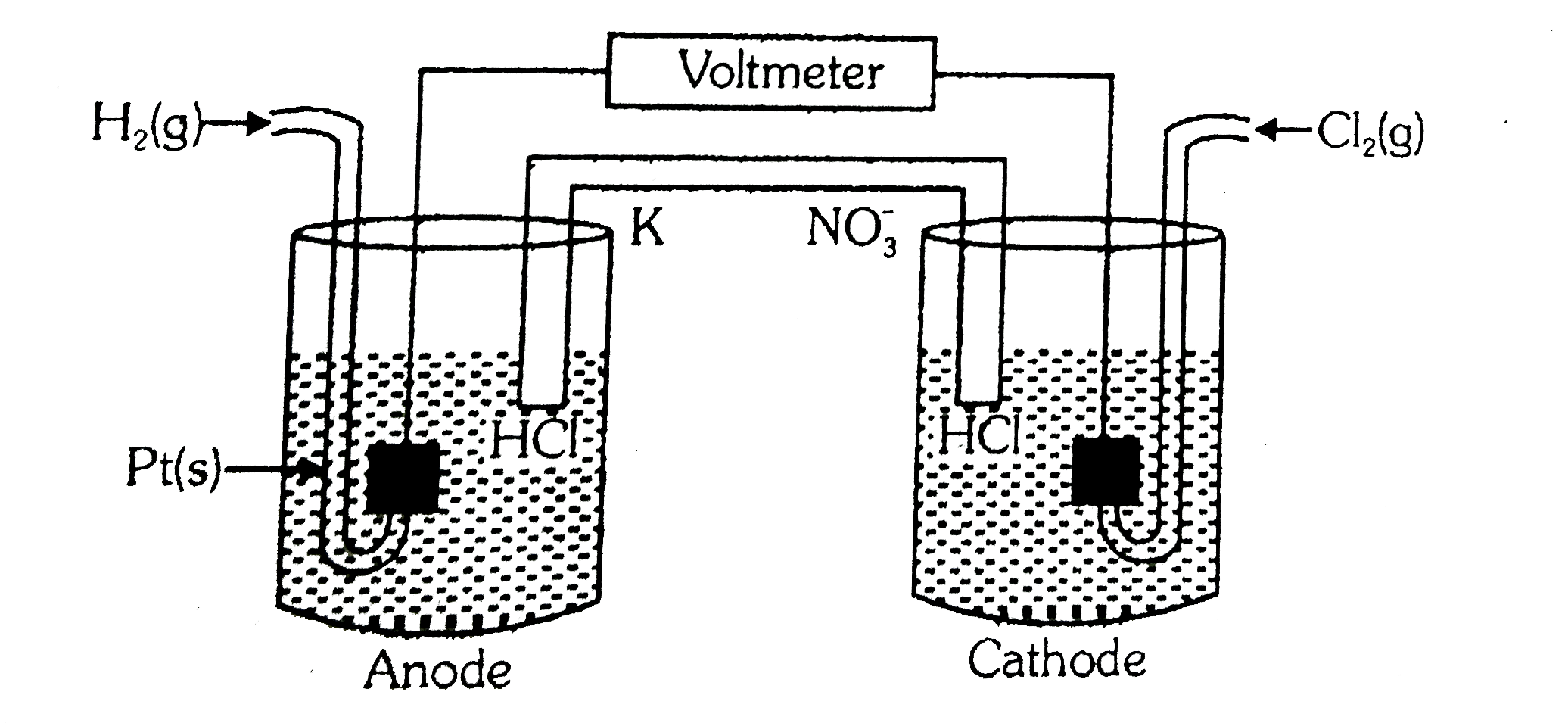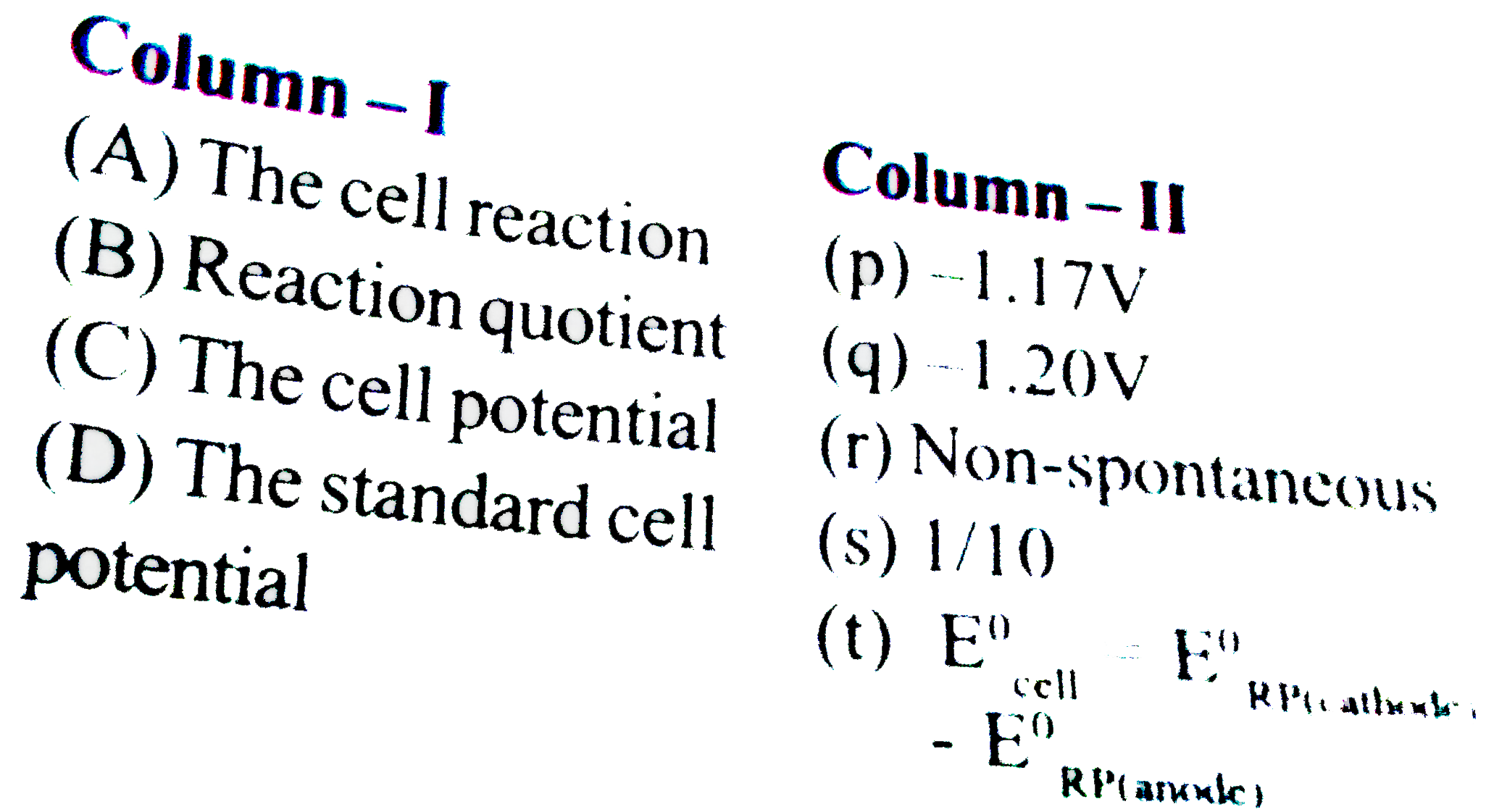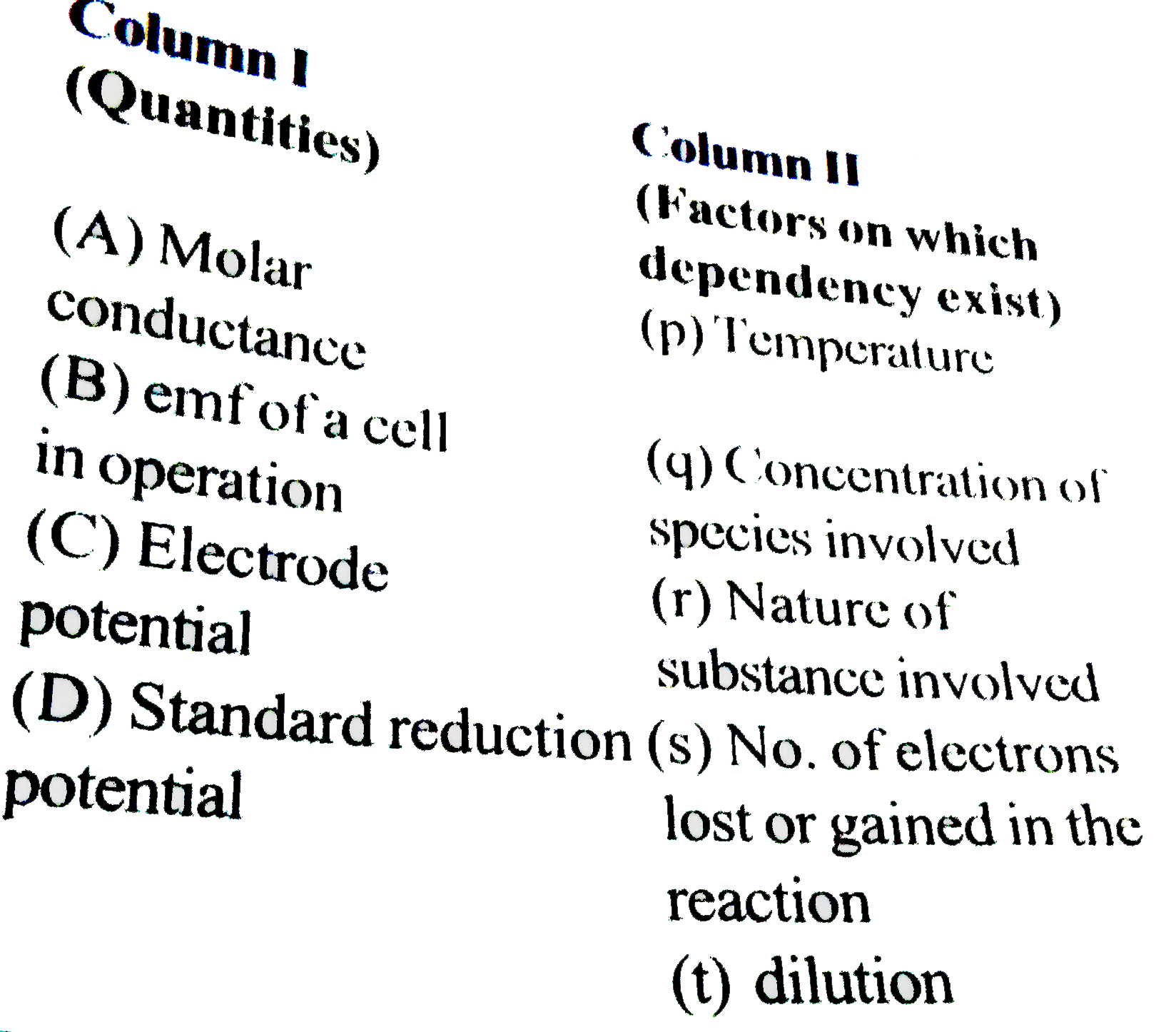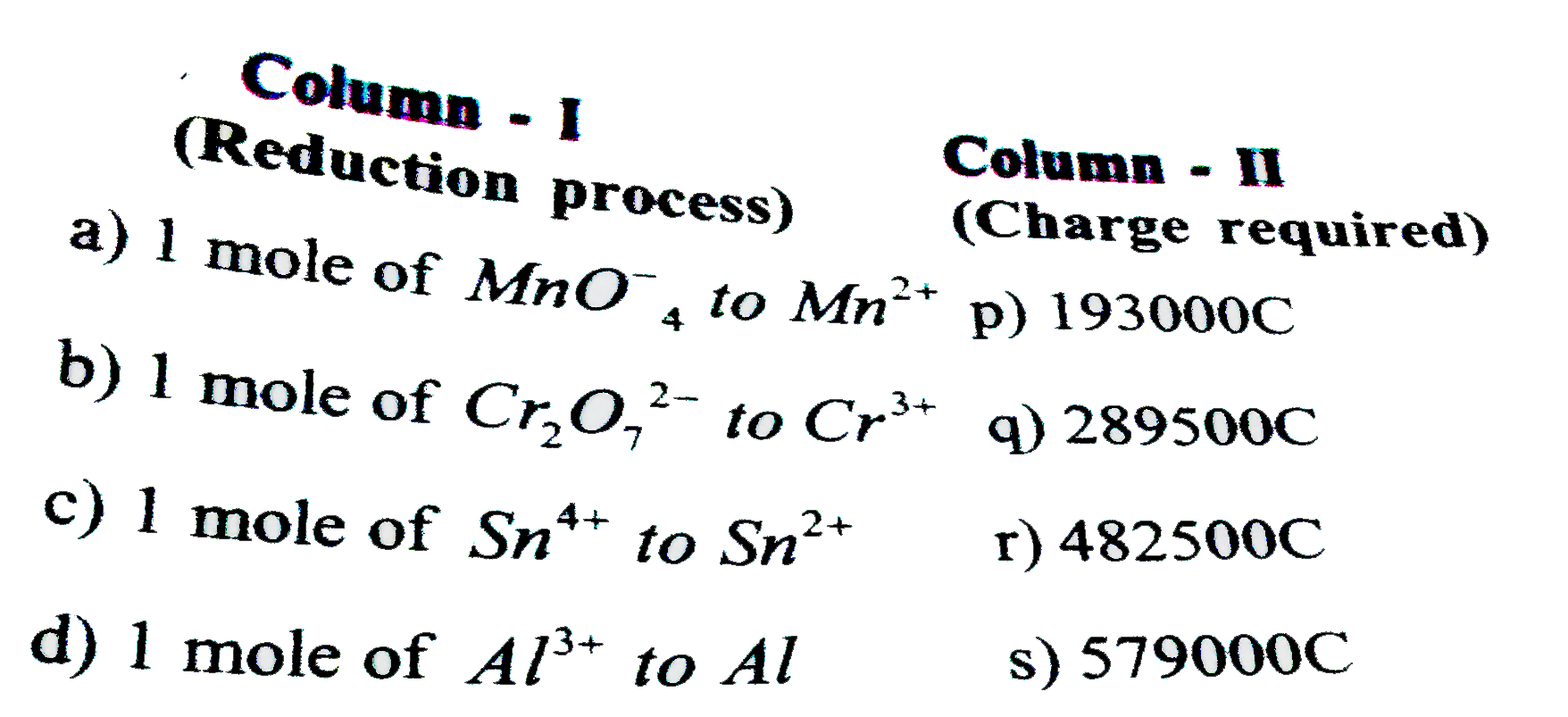Complete Solutions to LEVEL-V of chapter ELECTRO CHEMISTRY of Class 12 book with complete answers and questions
| Class 12 | CHEMISTRY |
| Chapter | ELECTRO CHEMISTRY |
| NARAYANA | LEVEL-V |
| Number Of Questions | 67 |
| Academic Year | 2023-24 |
Calculate the EMF of the electrode concentration cell Hg-Zn `(c_(1)M)|(Zn^(2+)(c M)|` Hg-Zn `(c_(2)M)` at `25^(@)C`, if the concentration of the zinc amalgam are 2 g per 100 g of mercury and 1g per 100 g of mercury in anode and cathode half-cell respectively.
View SolutionThe emf of a cell corresponding to the reaction
`Zn +2H^(+)(aq) rarr Zn^(2+) (0.1M) +H_(2)(g) 1` atm is `0.28` volt at `25^(@)C`. Calculate the `pH` of the solution at the hydrogen electrode.
`E_(Zn^(2+)//Zn)^(@) =- 0.76` volt and `E_(H^(+)//H_(2))^(@) = 0`
View SolutionThe elctrical resistance of a column of `0.05 M N aOH ` solution of diameter `1 cm` and length `50 cm` is `5.55 xx 10^(3)ohm`. Calculate its resisteivity , conductivity, and molar conductivity.
View SolutionA silver electrode is immersed in saturated `AgSO_(4(aq.))`. The potential difference between the silver and the standard hydrogen electrode is found to be `0.711 V`. Determine `K_(SP)(Ag_(2)SO_(4))`. Given `E_(Ag^(+)//Ag)^(@) = 0.799 V`.
View SolutionThe specific conductivity of AgCl (aq) at `25^(@)C` is `1.26 xx 10^(-6)` and ionic conductivity of `Ag^(+)`(aq) and `Cl^(-)`(aq) and 76 S `cm^(2) " mol"^(-1)` respectively. Then the solubility product of AgCl at `25^(@)C`
View SolutionThe equivalent conductance of `0.10 N` solution of `MgCI_(2)` is 97.1 mho `cm^(2) eq^(-1)`. A cell electrodes that are `1.50 cm^(2)` in surface are and `0.50` cm apart is filled with `0.1N MgCI_(2)` solution. How much current will flow when the potential difference between the electrodes is 5 volts?
View SolutionAn aqueous solution containing `Na^(+),Sn^(2+),Cl^(-) " & " SO_(4)^(2-)` ions, all at unit concentration, is electrolysed between a silver anode and a platinum cathode. What changes occur at the electrodes when current is passed through the cell ? Given : `E_(Ag^(+)|Ag)^(0)=0.799 V`
`E_(Sn^(2+)|Sn)^(@)=-0.14V, E_(Cl_(2)|Cl^(-))^(@)=1.36 V, E_(S_(2)O_(8)^(2-)|SO_(4)^(2-))^(@)=2V, E_(Sn^(4+)|Sn^(2+))^(@)=0.13V`
View SolutionA galvanic cell consists of two hydrogen electrodes. One is in a `1.0 M H^(+)` solution and other in a solution of unknown pH. The cell potential is 0.025V. The unknown pH is
View Solution`100mL` of buffer of `1 M NH_(3)(aq)` and `1 M NH_(4)^(o+)(aq)` are placed in two compartments of a voltaic cell separately. A current of `1.5A` is passed through both cells for `20 m i n`. If only electrolysis of water takes place, then
View SolutionAn acidic solution of `Cu^(2+)` salt contaning `0.4` of `Cu^(2+)` is electrolyzed untill all the copper is deposited. The electrolysis is continued for seven more minutes with the volume of solution kept at 100mL and the current at `1.2` amp. Calculate the volume of gases evolved at NTP during the entire electrolysis.
View SolutionCopper sulphate solution `(250 ML)` was electrolyzed using a platinum anode and a copper cathode. A constant current of `2mA` was passed for `16 mi n`. It was found that after electrolysis the absorbance of the solution was reducted to `50%` of its original value . Calculate the concentration of copper sulphate in the solution to begin with.
View SolutionUse the Standard Reduction Potentials given below to calculate `K_(f)` for `[Zn(NH_(3))_(4)]^(+2)` at `25^(@)`.
`Zn^(2+)(aq)+4NH_(3)(aq)ifZn(NH_(3))_(4)^(2+)(aq)`
`[Zn(NH_(3))_(4)]^(+2)+2e^(-)iffZn(s)+4NH_(3)(aq),`
`E^(@)=-1.04V , Zn^(2+)(aq)+2e^(-)iffZn(s),`
`E^(@)=-0.76V`
View SolutionThe charge required for the oxidation of one mole of `Mn_(3)O_(4)` to `MnO_(4)^(2-)` in alkaliine medium is (assume `100%` current efficiency):
View SolutionThe equilibrium constant for the reaction Sr(s) `+Mg^(+2)(aq)rarrSr^(+2)(aq)+Mg(s)` is `2.69 xx 10^(12)` at `25^(@)C`. The `E^(o)` for a cell mad up of the `Sr//Sr^(+2)` and `Mg^(+2)//Mg` half cells
View SolutionFor the fuel cell reaction `2H_(2)(g) +O_(2)(g) rarr 2H_(2)O(l), Deta_(f)H_(298)^(@) (H_(2)O,l) =- 285.5 kJ//mol` What is `DeltaS_(298)^(@)` for the given fuel cell reaction?
Given: `O_(2)(g) +4H^(+)(aQ) +4e^(-) rarr 2H_(2)O(l) E^(@) = 1.23 V`
View SolutionEquivalent conductane of 0.1 M HA (weak acid) solution is 10 S`cm^(2) "equivalent"^(-1)` and that at infinite dilution is 200 S `cm^(2) " equivalent"^(-1)` Hence pH of HA solution is
View SolutionThe dissociation constant of n-butyric acid is `1.6 xx 10^(-5)` and the molar conductivity at infinite dilution is `380 xx 10^(-4) Sm^(2) mol^(-1)`. The specific conductance of the `0.01M` acid solution is
View SolutionThe conductivity of a saturated solution of `Ag_(3)PO_(4)` is `9 xx 10^(-6) S m^(-1)` and its equivalent conductivity is `1.50 xx 10^(-4) Sm^(2) "equivalent"^(-1)`. Th `K_(sp)` of `Ag_(3)PO_(4)` is:-
View SolutionIn the Hall process, aluminium is produced by the electrolysis of molten `Al_2O_3`. How many second would it take to produce enough aluminium by the Hall process to make a case of 24 cans of auminium soft-drink, if each can uses 5.0g of Al, a current of 9650amp is employed and the current efficiency of the cell is 90%:
View SolutionHow much electricity in terms of Faraday is required to produce `20 g` of `Ca` from molten `CaCl_(2)` ?
View SolutionFor a cell reaction `2H_2(g)+O_2(g)to2H_2O(l)/_\_rS_(198)^(@)=-0.32KJ//k` . What is the value of `/_\_fH_(298)^(@)(H_2O,l)` ?
Given: `O_2(g)+4H^+(aq)+4e^-)to2H_2O(l), E^(@)=1.23V`
View SolutionDetermine the potential of the following cell:
`Pt|H_2(g,0.1 "bar")|H^+(aq,10^(-3)M"||"MnO_4^-)(aq),0.1M)`
`Mn^(2+)(aq,0.01M),H^+(aq,0.01M)|Pt`
Given : `E_(MnO_4^(-)|Mn^(2+))^(@)=1.51V`
View SolutionThe chlorate ion can disproportinate in basic solution according to reaction,
`2ClO_3^(-)iffClO_2^(-)+ClO_4^-)`
what is the equilibrium concentration of perchlorate ions from a solution initially at 0.1 M in chlorate ions at 298 K?
Given: `E_(Cl_4^(-)|ClO_3^(-))^(@)=0.36V "and" E_(Cl_3^(-)|ClO_2^(-))^(@)=0.33V "at"298 K`
View SolutionGiven the cell: `Cd(s)|Cd(OH)_2(s)|NaOH(aq,0.01M)|H_2(g,1"bar")|Pt(s)`
with `E_(cell)=0.0V."if"E_(Cd^(2+)|Cd)^(@)=-0.39V,"then"K_(sp)"of"Cd(OH_2)`is:
View Solutioncalculate the e.m.f (in V) of the cell:
`Pt|H_2(g)|BOH(Aq)"||"HA(Aq)|H_2(g)|Pt`,
0.1bar 1M 0.1M 1bar
Given : `K_a(HA)=10^(-7), K_b(BOH)=10^(-6)`
View SolutionGiven the following limiting molar conductivies at `25^(@)C,, Hcl, 426Omega^(-1)cm^(2)mol^(-1),NaCl, 126Omega^(-1)cm^(2)mol^(-1),NaC`(sodium crotonate) ,`83Omega^(-1)cm^(2)mol^(-1)`. What is the ionization constant of crotonic acid? If the conductivity of a `0.001M` crotonic acid `(HC)` solution is `3.83xx10^(-5)Omega^(-1)cm^(-1)`?
View SolutionThe conductivity of 0.001M `Na_2SO_4` solution is `2.6xx10^(-4)Scm^(-1)` and increases to `7.0xx10^(-4)Scm^(-1)`, When the solution is saturated with `CaSO_4`. The molar conductivities of `Na^+` and `Ca^(2+)` are 50 and 120`Scm^2mol^(-1)`, respectively. Neglect conductivity of used water. What is the solubility product fo `CaSO_4`?
View SolutionUse the following standard electrode potentials, calculate `DeltaG^(@)` in kJ`//`mol for the indicated reaction :
`5Ce^(4+)(aq)+Mn^(2+)(aq)+4H_(2)O(l)to5Ce^(3+)(aq)+MnO_(4)^(-)(aq)+8H^(+)(aq)`
`MnO_(4)^(-)(aq)+8H^(+)(aq)+5e^(-)toMn^(2+)(aq)+4H_(2)O(l), E^(@)=+1.51 V`
`Ce^(4+)(aq)+e^(=)toCe^(3+)(aq)" "E^(@)=+1.61 V`
View SolutionAssuming that hydrogen begaves as an ideal gas, calculate EMF of the cell at `25^(@)C` when
`P(1)=640mm and P_(2)=425mm`
`Pt|H_(2)(P_(1))|HCl|H_(2)(P_(2))|Pt`
View SolutionThe emf of the cell : `H_(2)(g)|"Buffer||Normal"` canlomel elctrolde is `0.6885V` at `25^(@)C`, when barometric pressure is `=760 mm`. What is the pH of the buffer solution? `E_("calomel")=0.28V`
View SolutionElectrode potential data are given below
`{:(Fe^(3+)(aq)+e^(-)rarrFe^(2+)(aq),E^(@)=+0.77V),(Al^(3+)(aq)+3e^(-)rarrAl(s),E^(@)=-1.66V),(Br_(2)(aq)+2e^(-)rarrBr^(-)(aq),E^(@)=+1.05V):}`
Based on the given data which statements is/are true?
View SolutionWe observe blue colour if:
View SolutionFor a strong electrolyte, equivalent conductance increases slowly with dilution and can be expressed by the relationship`: wedge_(m)=wedge^(@)._(m)-Asqrt(c)`
Which electrolyte (s) have same value of `A` ?
View SolutionEqual quantity of electricity is passed through three electrolytic cells containing aqueous solutions of `FeSO_(4),Fe_(2)(SO_(4))_(3)` and `Fe(NO_(3))_(3)`. Regarding the electrolytic process which of the following is/are correct, assuming at cathode only iron is reduced.
View SolutionSelect the wrong relations
View SolutionIn which of the following salt bridge is not needed ?
View SolutionConsider the following Galvanic cell:-

By what value the cell voltage when concentration of ions in anodic and cathodic compartments both increased by factor of 10 at 298K:
View SolutionThe specific conductivity of a saturated solution of AgCl is `3.40xx10^(-6) ohm^(-1) cm^(-1)` at `25^(@)C`. If `lambda_(Ag^(+)=62.3 ohm^(-1) cm^(2) "mol"^(-1)` and `lambda_(Cl^(-))=67.7 ohm^(-1) cm^(2) "mol"^(-1)`, the solubility of AgC at `25^(@)C` is:
View Solution`E_(RP)^(@)` and their respective half reactions for some change are given below:
i) `Mn^(7+)(aq)+8H^(+)+5erarrMn^(2+)(aq)+4H_(2)O(l),`
`E^(@)=+1.52V`
ii) `Mn^(7+)(aq)+4H^(+)+3erarrMnO_(2)(s)+2H_(2)O(l),`
`E^(@)=+2.26V`
iii) `Mn^(7+)(aq)+2erarrMn^(5+)(aq),`
`E^(@)=+0.56V("acid med.")`
`Mn^(3+)+erarrMn^(2+)`,
`E^(@)=+1.51V("acil med.")`
v) `Mn^(4+)+erarrMn^(3+),`
`E^(@)=+0.95V("acid med.")`
The most stable oxidation state of Mn is:
View Solution`E_(RP)^(@)` and their respective half reactions for some change are given below:
i) `Mn^(7+)(aq)+8H^(+)+5erarrMn^(2+)(aq)+4H_(2)O(l),`
`E^(@)=+1.52V`
ii) `Mn^(7+)(aq)+4H^(+)+3erarrMnO_(2)(s)+2H_(2)O(l),`
`E^(@)=+2.26V`
iii) `Mn^(7+)(aq)+2erarrMn^(5+)(aq),`
`E^(@)=+0.56V("acid med.")`
`Mn^(3+)+erarrMn^(2+)`,
`E^(@)=+1.51V("acil med.")`
v) `Mn^(4+)+erarrMn^(3+),`
`E^(@)=+0.95V("acid med.")`
Which is the least stable oxidation state of Mn?
View Solution`E_(RP)^(@)` and their respective half reactions for some change are given below:
i) `Mn^(7+)(aq)+8H^(+)+5erarrMn^(2+)(aq)+4H_(2)O(l),`
`E^(@)=+1.52V`
ii) `Mn^(7+)(aq)+4H^(+)+3erarrMnO_(2)(s)+2H_(2)O(l),`
`E^(@)=+2.26V`
iii) `Mn^(7+)(aq)+2erarrMn^(5+)(aq),`
`E^(@)=+0.56V("acid med.")`
`Mn^(3+)+erarrMn^(2+)`,
`E^(@)=+1.51V("acil med.")`
v) `Mn^(4+)+erarrMn^(3+),`
`E^(@)=+0.95V("acid med.")`
The `E^(@)` for, `Mn^(4+)+2erarrMn^(2+),` is equal to:
View SolutionThe molar conductance of NaCl vauies with the concentration as shown in the following table. And all values follows the equation `lambda_(m)^(C)=lambda_(m)^(oo)-bsqrtC` Where `lambda_(m)^(C)`= molar specific conductance `lambda_(m)^(oo)`=molar specific conductance at infinite dilution C = molar concentration `{:("Molar concentration","Molar conductance of NaCl in ohm"^(-1)"cm"^(2)"mole"^(-1)),(4xx10^(-4),107),(9xx10^(-4),97),(16xx10^(-4),87):}`
When a certain conductivity cell (C) was filled with `25xx10^(-4)(M)` NaCl solution. The resistance of the cell was found to be 1000 ohm. At Infinite dilution, conductance of `CI^(-)` and `SO_(4)^(-2)` are 80 `ohm^(-1)cm^(2)"mole"^(-1)` and 160 `ohm^(-1)cm^(2)"mole"^(-1)` respectively.
What is the molar conductance of NaCl at infinite dilution?
View SolutionThe molar conductance of NaCl vauies with the concentration as shown in the following table. And all values follows the equation `lambda_(m)^(C)=lambda_(m)^(oo)-bsqrtC` Where `lambda_(m)^(C)`= molar specific conductance `lambda_(m)^(oo)`=molar specific conductance at infinite dilution C = molar concentration `{:("Molar concentration","Molar conductance of NaCl in ohm"^(-1)"cm"^(2)"mole"^(-1)),(4xx10^(-4),107),(9xx10^(-4),97),(16xx10^(-4),87):}`
When a certain conductivity cell (C) was filled with `25xx10^(-4)(M)` NaCl solution. The resistance of the cell was found to be 1000 ohm. At Infinite dilution, conductance of `CI^(-)` and `SO_(4)^(-2)` are 80 `ohm^(-1)cm^(2)"mole"^(-1)` and 160 `ohm^(-1)cm^(2)"mole"^(-1)` respectively.
What is the cell constant of the conductivity cell (C) :
View SolutionThe molar conductance of NaCl vauies with the concentration as shown in the following table. And all values follows the equation `lambda_(m)^(C)=lambda_(m)^(oo)-bsqrtC` Where `lambda_(m)^(C)`= molar specific conductance `lambda_(m)^(oo)`=molar specific conductance at infinite dilution C = molar concentration `{:("Molar concentration","Molar conductance of NaCl in ohm"^(-1)"cm"^(2)"mole"^(-1)),(4xx10^(-4),107),(9xx10^(-4),97),(16xx10^(-4),87):}`
When a certain conductivity cell (C) was filled with `25xx10^(-4)(M)` NaCl solution. The resistance of the cell was found to be 1000 ohm. At Infinite dilution, conductance of `CI^(-)` and `SO_(4)^(-2)` are 80 `ohm^(-1)cm^(2)"mole"^(-1)` and 160 `ohm^(-1)cm^(2)"mole"^(-1)` respectively.
It the cell (C) is filled with `5xx10^(-3)(N)Na_(2)SO_(4)` the obserbed resistance was 400 ohm. What is the molar conductance of `Na_(2)SO_(4)`.
View SolutionRedox reactions play a vital role in chemistry and biology. The values of standard redox potential `(E^(@))` of two half-cells reactions decide which way the reaction is expected to proceed. A simple example is a Daniell cell in which zince goes into solution and copper gets deposited. Given below are set of half-cell reactions (acidic medium ) along with their `E^(@)` in V with respect to normal hydrogen electrode values.
`{:(l_(2)+2e^(-)rarr2l^(-),E^(@)=0.54),(Cl_(2)+2e^(-)rarr2Cl^(-)" ",E^(@)=1.36),(Mn^(3+)+e^(-)rarrMn^(2+),E^(2)=1.50),(Fe^(3+)+e^(-)rarrFe^(2+)" ",E^(@)=0.77),(O_(2)+4H^(+)+4e^(-)rarr2H_(2)O,E^(@)=1.23):}`
Among the following, identify the correct statement
View SolutionRedox reactions play a vital role in chemistry and biology. The values of standard redox potential `(E^(@))` of two half-cells reactions decide which way the reaction is expected to proceed. A simple example is a Daniell cell in which zince goes into solution and copper gets deposited. Given below are set of half-cell reactions (acidic medium ) along with their `E^(@)` in V with respect to normal hydrogen electrode values.
`{:(l_(2)+2e^(-)rarr2l^(-),E^(@)=0.54),(Cl_(2)+2e^(-)rarr2Cl^(-)" ",E^(@)=1.36),(Mn^(3+)+e^(-)rarrMn^(2+),E^(2)=1.50),(Fe^(3+)+e^(-)rarrFe^(2+)" ",E^(@)=0.77),(O_(2)+4H^(+)+4e^(-)rarr2H_(2)O,E^(@)=1.23):}`
while `Fe^(3+)` is stable, `Mn^(3+)` is not stable in acid solution because :
View SolutionThe concentration of potassium ions inside a biological cell is at least twenty times higher than the outside. The resulting potential difference across the cell is important in several processes such as transmission of nerve impulses and maintaining the ion balance. A simple mode for such a concentration cell involving a metal `M` is :
`M_((s))|M_((aq.))^(@) 0.05"molar"||M_((aq.))^(@) 1"molar"|M_((s))`
For the above electrolytic cell the magnitude of the cell potential `|E_(cell) | = 70mV`
For the above cell :
View SolutionThe concentration of potassium ions inside a biological cell is at least 20 times higher than outside. The resulting potential difference across the cell is important in several processes such as transmission of nerve impulses and maintaining the ion balance. A simplel model for a concentration cell involving a metal `M` is
`M(s)|M^(o+)(aq,0.05 ` molar`)||M^(o+)(aq,1` molar`)|M(s)`
For the abov electrolytic cell, the magnitude of the cell potential is `|E_(cell)|=70mV.`
If the `0.05` moolar solution of `M^(o+)` is replaced by a `0.0025` molar `M^(o+)` solution, then the magnitude of the cell potential would be
View SolutionThe electrochemical cell shown below is a concentration cell
`M//M^(2+)` (saturated solution of a sparingly soluble salt, `MX_(2))||M^(2+)(0.001 mol dm^(-3))|M`
The emf of the cell depends on the difference in concentrations of `Mn^(2+)` ions at the two electrodes. The emf of the cell at `298 K` is `0.059 V`.
The value of `DeltaG ( kJ "mol"^(-1))` for the given cell is : (take `1 F = 96500 C "mol"^(-1)`)
View SolutionThe electrochemical cell shown below is a concentration cell. `M|M^(2+)(` saturated solution of sparingly soluble salt, `MX_(2))||M^(2+)(0.001 mol dm^(-3))|M`
The `emf` of the cell depends on the difference in the concentration of `M^(2+)` ions at the two electrodes. The `emf` of the cell at `298` is `0.059V`.
The solubility product `(K_(sp),mol^(3) dm^(-9))` of `MX_(2)` at 298 based on the information available the given concentration cell is `(` Take `2.303xxRxx298//F=0.059V)`
View SolutionFor the galvanic cell
`Ag|Ag_((aq))^(+)(0.1M)"||"Cd_((aq))^(2+)(0.1M)|Cd`
`(E_(Ag^(+)//Ag)^(0)=0.80V,E_(Cd^(2+)//Cd)^(0)=-0.40V)`,

View SolutionMatch the following columns

View SolutionMatch the following columns

View SolutionMatch the following columns

View SolutionStatement : The cathode of electrolytic cell during electrolysis of `NaCl_((aq.))` on additon of little litmus shows a blue colour.
Explanation : At cathode : `2H^(+) + 2e rarr H_(2)`. The reaction at cathode give rise to an increase in `pH` ranging in alkaline medium and litmus shows blue colour.
View SolutionStatement : `Pt_(H_(2))|HCl ` at `25^(@)C E_(H) = 0`.
Explanation : For primary reference electrode `E_(H//H^(+))^(@) = 0`
View SolutionStatement : `((deltaE)/(deltaT))_(P)` is called temperature coefficient of emf.
Explanation : `((deltaE)/(deltaT))_(P)` may be `+ve, -ve` and depends upon heat of reaction.
View SolutionStatement : Liquid juncation potential can be eliminated by putting a salt bridge of `KCl`.
Explanation : The funcation of salt bridge is to remove liquid junction potential because the salt used has same speed of cathions and anions.
View SolutionAssertion`(A):` Whne acidified `ZnSO_(4)` solution is electrolyzed between `Zn` electrodes, it is `Zn` that is deposited at the cathode and `H_(2)(g)` is not evolved.
Reason `(R):` The electrode potential of `Zn` is more negative than hydrogen as the overpotential for hydrogen evolution in `Zn` is quite large.
View SolutionAssertion `(A):` The mobility of `Na^(o+)` is lower than that of `K^(o+)` ion.
Reason `(R): ` The ionic mobility depends upon the effective radius of the ion.
View SolutionStatement : `E_(cell)^(@)` is an intensive property
Explanation : `DeltaH^(@)//n` is also intensive property
View SolutionStatement : If two half reaction with electrode potential `E_(1)^(@)` and `E_(2)^(@)` gives a third reaction then,
`DeltaG_(3)^(@) = DeltaG_(1)^(@) + DeltaG_(2)^(@)`
Explanation : `E_(3)^(@) = E_(1)^(@) + E_(2)^(@)`
View SolutionFind the volume of `Cl_(2)` at `NTP` produced during electrolysis of `MgCl_(2)` which produces `6.6 g Mg`. `("At.wt. of " Mg = 24.3)`
View SolutionThe standard oxidation potential of `Ni//Ni^(2+)` electrode is `0.236 V`. If this is combined with a hydrogen electrode in acid solution, at what `pH` of this solution will be measured e.m.f. be zero at `25^(@)C`? Assume that `[Ni^(2+)] = 1 M` and `P_(H_(2)) = 1 atm`.
View SolutionA hydrogen electrode is dipped in a solution at `25^(@)C`. The potential of cell is `-0.177 V`. Calcualte the `pH` of the solution.
View SolutionWhat current is to be passed for `0.25` sec for deposition of certain weight of metal which is equal to its electrochemical equivalent ?
View SolutionWhen water is electrolysed, hydrogen and oxygen gas are produced. If 1.008 g of `H_(2)` is liberated at the cathode. What mass of `O_(2)` is formed at the anode?
View Solution
LEVEL-V questions and complete solutions for chapter ELECTRO CHEMISTRY of NARAYANA CHEMISTRY (HINGLISH) of Class 12